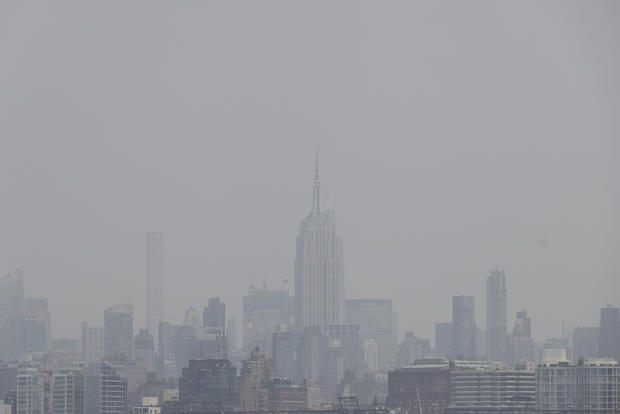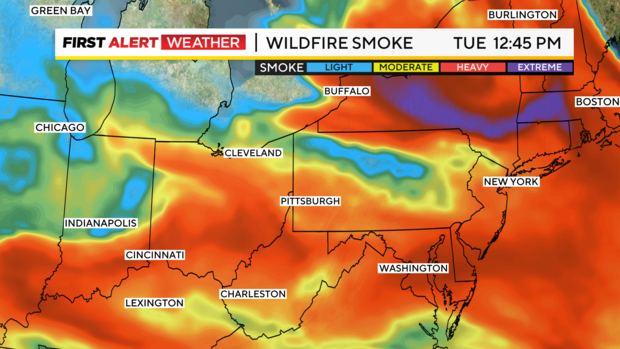▶ Watch Video: Canadian wildfires causing air quality concerns in Northeastern U.S.
People in New York City and across the northeastern United States woke up Tuesday morning to an unusual sight. Depending on the time, early risers reported witnessing either the moon or the sun bearing a reddish glow. It was not the first time in recent weeks that both the sun and the moon have turned red in skies over various parts of the Northeast and the Pacific Northwest, as wildfires burning in eastern and western Canada continue to send smoke down the border.
Canada is experiencing one of its worst wildfire seasons on record, with more than 6.7 million acres already burned since the beginning of the year, officials said during a news conference last week. The blazes are especially severe right now in the country’s eastern provinces, with wildfires raging in Quebec and Nova Scotia that forced roughly 14,000 people to evacuate, CBC News reported.
Winds rotating around a stationary, low-pressure system hovering over the eastern provinces of New Brunswick, Nova Scotia and Prince Edward Island, known as the Canadian Maritimes, are directing smoke from the wildfires toward the northeastern U.S., Matt Sitkowski, the science editor in chief at The Weather Channel, told CBS News on Tuesday.
The smoke is causing the sun and the moon to appear red behind grey, hazy skies, said Sitkowski. Because the color of the sky is determined based on how sunlight interacts with the number and size of particles in the air, it changes with the infiltration of smoke, which introduces more particulate matter into the atmosphere.
“The sky is blue, for example, because small particles in the atmosphere scatter short wavelengths of the visible light spectrum more strongly than long wavelengths,” Sitkowski said, noting that blue-colored light has shorter wavelengths while red-colored light has longer ones.
“When smoke is in the atmosphere, it not only makes the sun dimmer, it increases the amount and size of particulate matter in the atmosphere that absorbs more of the shorter wavelengths, leaving longer wavelengths to reach our eyes,” he explained.
Why is there an air quality alert?
The red sun and moon over northeastern U.S. states this week came with a series of air quality alerts that impacted millions of people on Tuesday, some living as far west as Ohio and Missouri and as far south as North Carolina.
An air quality health advisory was in effect for most of New York State, according to the New York State Department of Environmental Conservation, which said affected regions included the New York City metropolitan area, Lower Hudson Valley, Upper Hudson Valley, Adirondacks, Eastern Lake Ontario and Central Regions. Alerts were also effective in parts of Delaware, Maryland, Massachusetts, Philadelphia and much of North Carolina, as well as in Columbus and St. Louis.
Officials said air quality was considered “unhealthy for sensitive groups” in places where alerts were issued Tuesday, but likely would not harm the general public. Sensitive groups, including older adults and children, as well as people with asthma and other preexisting respiratory conditions, are encouraged to limit strenuous outdoor activity for long periods while the health advisory is active.
In general, the air quality index measures pollution by the amount of solid and liquid fine particles found in a given airspace, and weather authorities have recognized that the pollution happening Tuesday was linked to smoke plumes from at least 100 wildfires burning across the border in Quebec and Ottawa.
“Air quality has plummeted across much of the northeast as smoke from wildfires in Canada moves south,” the National Weather Service wrote in a tweet. “Poor air quality can be hazardous. Before spending time outdoors, check the air quality forecast. Make sure you aren’t doing yourself more harm than good.”
Officials expect that winds will continue to blow smoke from the Canadian wildfires toward the Northeast until Wednesday at the earliest. The Midwest experienced similar consequences of wildfires across the border earlier in the week, with the Minnesota Pollution Control Agency saying in a tweet on Monday that “a band of smoke from wildfires in Quebec will continue to linger across east central and southeast Minnesota today due to very light winds.”
What’s causing the fires in Canada?
There were 413 active wildfires burning across Canada as of Sunday, CBC News reported, citing federal officers like Michael Norton, an official with Canada’s Natural Resources ministry, who said earlier this week that it is unusual for the country to see such a large coast-to-coast spread of wildfires at this time of year. Wildfires in Canada are typically sparked by lightning strikes, although human-caused fires have erupted into more significant blazes as well, Norton said.
The map below, created by the CBS affiliated radio station KDKA on Tuesday afternoon, shows the expanse of smoke plumes currently emanating from Canada’s wildfires and entering the U.S.
“Wildfire smoke can travel thousands of miles and linger in the air for days,” Sitkowski said. “How the smoke is dispersed is a function of the larger weather pattern,” like the direction of the wind and its strength. “Smoke also exists at different levels of the atmosphere, with the most hazardous to our health being when it is closer to the ground.”




































